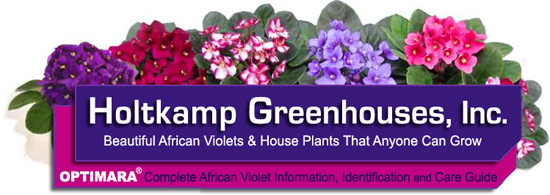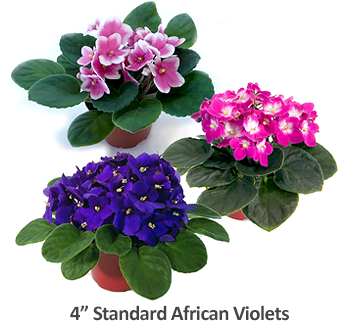 African Violet Care: Basic Summary
African Violet Care: Basic Summary
Light: Moderate to bright, indirect, indoor light.
Watering: Keep soil moist to dry, and allow soil around roots to dry out before
watering to encourage blooming. Water from the bottom with room temperature
water by placing the plastic grower's pot in water, and allowing the plant
to absorb the water ( not more than 30 minutes ).
Avoid getting water on the
leaves as this can cause spotting damage. For best results, use violet plant
food as directed.
Tips:
Pinch off spent blossoms and blossom
stems to encourage development of new blooms.
Place plants away from floor
vents, fans, or
entrance doors to avoid air drafts and bursts of cold air.

Water
 In general, African Violets need just enough
water to keep the soil moist, but never soggy. Too much waterwill leave
your African Violets susceptible to such deadly pathogens as Pythium, Root
Rot and Crown Rot. Overwatering can also cause denitrification,
a condition which prevents plants from getting the nitrogen they need.
In general, African Violets need just enough
water to keep the soil moist, but never soggy. Too much waterwill leave
your African Violets susceptible to such deadly pathogens as Pythium, Root
Rot and Crown Rot. Overwatering can also cause denitrification,
a condition which prevents plants from getting the nitrogen they need.
The water should be room temperature, or as
close as possible in temperature to the air around your plants. When the
water is too cold, it chills the roots of African Violets, causing leaves
to curl down as the water is absorbed into the plant. Also, if watering
from the top, cold water can cause leaf spotting. Such spots represent a
form of necrosis and, as such, cannot be removed. (Note: Whether the water
is the correct temperature or not, it is always important not to get water
on the leaves. The only exception to this is when you are spray misting
for purposes of quick-feeding or increasing the humidity around your plants.
Such misting will not leave behind the large water droplets which, when
exposed to the sun, will produce brown spots on the leaves.)
Never use soft water. Soft water increases
the saline content. This will alter both the pH and the electrical conductivity
of the soil, thereby diminishing your African Violet's ability to absorb
water and nutrients. If you have soft water, you may be able to divert water
before it reaches the softening unit. If not, you will need to seek an alternative
source of water.
Avoid using highly chlorinated water. While
some chlorine is actually necessary for photosynthesis to occur, African
Violets need very little, i.e., 70-100 ppm. Such minute traces in the water
will not be discernible by smell. In fact, if you can smell chlorine, then
your water has too much. The consequences of using water with too much chlorine
in it include leaf burn and diminished flowering. If you have highly chlorinated
water, and no alternative source is available, dispense water into a container
and let stand overnight to allow the chlorine gas to escape.
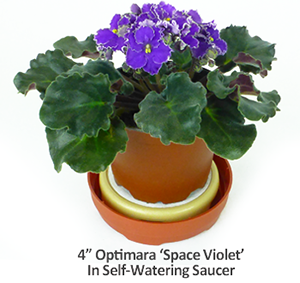 To insure correct watering, you are strongly
encouraged to use a recommended self-watering device, such as the Optimara MaxiWell (for 4-inch
standard Violets), MiniWell (for 1-inch super miniatures) or the Optimara WaterShip container, a spill-proof, self-watering
device for 2-inch miniatures. By providing the correctamount of water,
a good self-watering device will greatly reduce the chances of getting any
of the deadly fungi which cause plants to rot. In addition, because a good
self-watering device waters from the bottom, it eliminates the potential
hazards of watering from the top, i.e., leaf spots.
To insure correct watering, you are strongly
encouraged to use a recommended self-watering device, such as the Optimara MaxiWell (for 4-inch
standard Violets), MiniWell (for 1-inch super miniatures) or the Optimara WaterShip container, a spill-proof, self-watering
device for 2-inch miniatures. By providing the correctamount of water,
a good self-watering device will greatly reduce the chances of getting any
of the deadly fungi which cause plants to rot. In addition, because a good
self-watering device waters from the bottom, it eliminates the potential
hazards of watering from the top, i.e., leaf spots.
Finally, there are some
self-watering devices which, while providing the benefits already mentioned,
will also increase the humidity in the area immediately around your Violets.
A self-watering device of this type, such as the Watermaid (for pot sizes up to 5-1/2 inches), stores water in an open saucer and draws
water into the soil via capillary matting. All of the above self-watering
devices are available online at the Selective
Gardener, a mail order supplier that specializes in plant care products
made specifically for African Violets.

Light Requirements
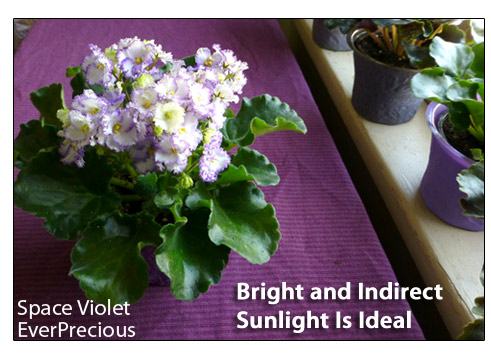 The amount of light that an African Violet receives is important for
its health and overall performance. They thrive in moderate to bright, indirect, indoor light.
The amount of light that an African Violet receives is important for
its health and overall performance. They thrive in moderate to bright, indirect, indoor light.
African Violets, like other plants,
need light for photosynthesis. While photosynthesis
is most often associated with a plant's green leaves and stems, its most
vital function is to convert carbon, hydrogen and oxygen (in the form of
carbon dioxide and water) into usable energy called plant
carbohydrates. Even when all the essential nutrients are available to the
plant, a complete absence of sunlight will literally
result in starvation.
More common, of course, is a plant which simply does
not get enough sunlight. In such circumstances, an African Violets will
stop flowering and its leaves begin to turn yellow. It is also likely that
the African Violet, which is not getting enough sunlight, will become rangy
as it develops elongated leaves and stems.
While insufficient sunlight can be harmful,
too much sunlight can also cause problems. Among other symptoms, too much
sunlight will produce brown spots on the leaves and flowers. This is a form
of necrosis analogous to sunburn. In addition, too much sunlight can cause
the leaves to curl down and may turn variegated leaves entirely green.
 African Violets perform best when they receive
a lot of indirect sunlight.
African Violets perform best when they receive
a lot of indirect sunlight.
While African Violets will tolerate direct sunlight
very early or very late in the day, they should, in all other cases, be
shielded from direct sunlight. For best results, place your Violets in a
window where they will receive light most of the day, i.e., a window with
western or southern exposure. Adjust your blinds or use a sheer curtain
to filter out some of the light. If you have access to a light meter, the
correct luminosity for African Violets is 10,000 to 12,000 lux, or about
900 to 1100 foot candles. As an alternative, you can get a reasonable approximation
of this light value by simply holding your hand over a Violet during the
time when it is receiving the brightest light. If you can barely see the
shadow of your hand over the Violet, then it is getting the correct amount
of light.
Keep in mind that the duration and intensity of sunlight will vary with
the seasons. During the winter months, you may need to allow your African
Violets to get more sunlight than they would ordinarily receive. Also, it
is important to rotate your African Violets so that they receive an equal
amount of sunlight on all sides. They should be rotated one-quarter turn,
about once a week or each time you water. If African Violets are not rotated
in this manner, they will begin to bend towards the light and grow larger
on the side closest to the window. This reaction is not peculiar to African
Violets. For almost all plants, it is simply a phototropic response which
allows a plant to get optimal sunlight.
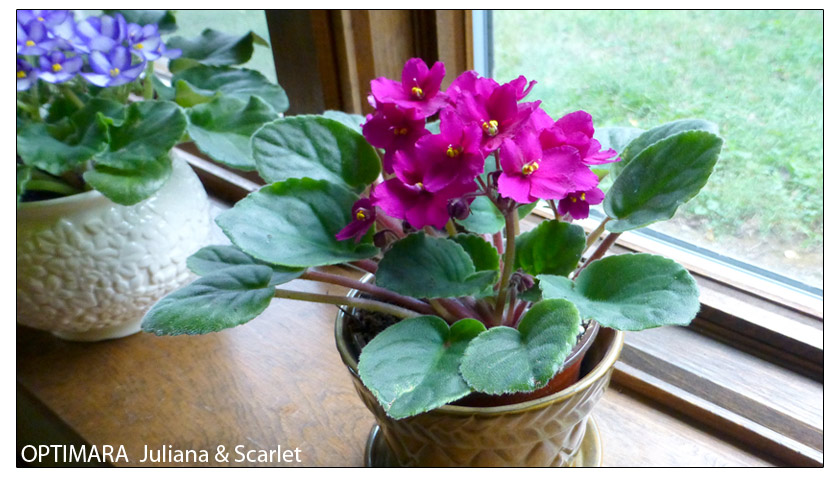 If you use artificial lighting, i.e., grow
lights, your African Violets will be subject to a number of special considerations. First, when selecting a grow light, it is important to make sure it emits
light in both the red and blue spectrums. Red
light is essential for African Violets to bloom. Blue
light is necessary for photosynthesis to occur and, thus, is vital for the
development of green leaves and the production of plant carbohydrates.
If you use artificial lighting, i.e., grow
lights, your African Violets will be subject to a number of special considerations. First, when selecting a grow light, it is important to make sure it emits
light in both the red and blue spectrums. Red
light is essential for African Violets to bloom. Blue
light is necessary for photosynthesis to occur and, thus, is vital for the
development of green leaves and the production of plant carbohydrates.
Second, keep in mind that the intensity of light will increase as the
distance from the source decreases. For this reason, it is important to
mount your grow light at the proper distance above the plant. If the African
Violet is too close to the grow light, it will begin to develop symptoms
similar to those resulting from too much sunlight, i.e., leaf scorch. While
you should give preference to any instructions accompanying your particular
grow light, grow lights should generally be mounted 18 to 20 inches above
the tops of standard African Violets. For miniatures, grow lights may need
to be lowered to about 10 to 12 inches above the tops of the plants.
Third, it is important to remember that African
Violets need at least eight hours of darkness, each day, in order to bloom. While African Violets need a sufficient duration of light to produce florigen (floweringhormone), florigen itself does
not trigger blooming until it is dark. For this reason, African Violets
should receive light for no more than 16 hours a day. To properly regulate
the duration of light, you may want to consider getting a timer for your
grow lights.
Finally, you should be aware of a condition
peculiar to African Violets which are cultivated under grow lights. This
condition is called Leaf Bleaching. While not all African Violets are sensitive
to this condition, those that are will develop leaves which are distinctly
lighter on those areas directly exposed to the light. Often, these lighter
areas will also exhibit a slight pinkish cast. The only way to treat this
condition is to stop using grow lights and begin using sunlight.

Temperature and Air Quality
 In terms of temperature, humidity and other factors of air quality, African
Violets thrive in an environment which most people would consider pleasant.
Therefore, if you feel comfortable, chances are, your African Violets are
feeling comfortable as well. However, in case you are one of those people
who thrive in otherwise unhealthy circumstances, you will need to know a
little about the conditions preferred by African Violets.
In terms of temperature, humidity and other factors of air quality, African
Violets thrive in an environment which most people would consider pleasant.
Therefore, if you feel comfortable, chances are, your African Violets are
feeling comfortable as well. However, in case you are one of those people
who thrive in otherwise unhealthy circumstances, you will need to know a
little about the conditions preferred by African Violets.
In general, you should keep the air temperature,
around your African Violets, as close as possible to 70 degrees F. At the
very least, do not allow temperatures to drop below 60 degrees or rise above
80 degrees. Also, while extreme variations in temperature should always
be avoided, do not be concerned about slight fluctuations between day and
night-time temperatures. In fact, some African Violet hybrids require fluctuations
of as much as 10 degrees in order to produce optimal flowering. However,
if your African Violets are exposed to extreme temperatures, even for a
very short period of time, they may suffer. When
the temperature is too warm, plant growth will become rangy (i.e., elongated
stems and leaves), leaves will appear dry and shriveled, and flowers will
begin to dropoff. If you know that the temperature is too warm, gradually
reduce it to about 70 degrees F. While doing so, keep in mind that a change
in temperature will have a corresponding effect
on transpiration and evaporation rates. Therefore, depending on how long
your African Violet has been exposed to excessive heat, you may need to
decrease the frequency with which it receives water. To gauge the impact
on water, it will help to know that the rate of evaporation from leaves
drops by half with each decrease of 20 degrees F.
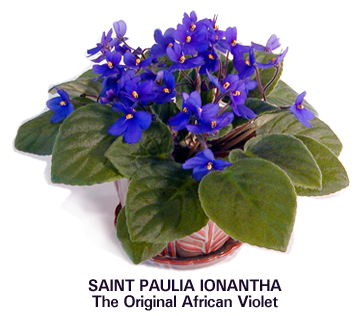 While excessive heat will cause your African
Violets to suffer, they are not nearly as deadly as cold temperatures. At
the very least, African Violets will stop flowering, and plant growth will
be slow. In more severe cases, leaves and flowers will rapidly begin to
wilt, and the plant will go into shock. Moreover, cooler temperatures leave
African Violets vulnerable to such deadly pathogens as Crown Rot, especially
when accompanied by excessive moisture. Depending on the extent to which
your African Violet has been exposed to cold temperatures, you may or may
not be able to save it. Once an African Violet begins to show symptoms of
exposure, it is often too late, especially since it may take up to 36 hours
for symptoms to appear.
While excessive heat will cause your African
Violets to suffer, they are not nearly as deadly as cold temperatures. At
the very least, African Violets will stop flowering, and plant growth will
be slow. In more severe cases, leaves and flowers will rapidly begin to
wilt, and the plant will go into shock. Moreover, cooler temperatures leave
African Violets vulnerable to such deadly pathogens as Crown Rot, especially
when accompanied by excessive moisture. Depending on the extent to which
your African Violet has been exposed to cold temperatures, you may or may
not be able to save it. Once an African Violet begins to show symptoms of
exposure, it is often too late, especially since it may take up to 36 hours
for symptoms to appear.
If your African Violet has been exposed to cold temperatures, move it
immediately to a place where the temperature is warm. Next, remove any tissue
which has become dark and mushy. This will prevent the spread of rot. Discontinue
watering and fertilizing, but maintain high humidity. One way to do this
is to employ the bag method. Place your African Violet in a clear plastic
bag and close the top with a wire twist. If your African Violet is going
to survive, you will begin to see signs of recovery within a few days. However,
to allow full recovery, you should keep the Violet bagged for about one
week. At this time, once you have removed it from the bag, it should be
safe to return your African Violet to its normal watering and fertilizing
schedule.
As with relatively warm temperatures, humidity
is vital to the health of African Violets. In their native habitat, in the
Usambara Mountains of East Africa, the relative humidity is generally about
70 to 80 percent. While this level of humidity would be difficult to maintain
in most homes, you should try to provide your African Violets with at least
50 to 60 percent humidity. If the level of humidity is much less than this,
an African Violet's transpiration rate will be greater than its ability
to absorb water. As a consequence, buds will fail to open, plant growth
will be slow, and leaves will begin to appear dry and shriveled.
If necessary, there are a number of ways to increase the amount of humidity
around your African Violets. First, you can create a favorable microclimate
by grouping your African Violets together. This, by itself, can increase
the humidity around your plants by as much as 15 percent. However, when
doing so, it is important not to place your African Violets so 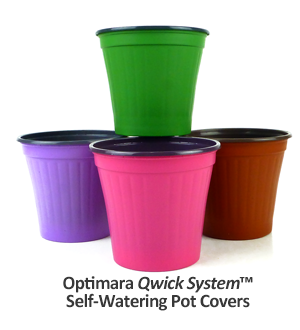 closely together
that the leaves are touching. While maintaining high humidity is essential,
it is also important to give your Violets enough room to grow and to maintain
sufficient air circulation in order to prevent the growth of potentially
dangerous fungi.
closely together
that the leaves are touching. While maintaining high humidity is essential,
it is also important to give your Violets enough room to grow and to maintain
sufficient air circulation in order to prevent the growth of potentially
dangerous fungi.
Another way to increase humidity is to use a self-watering device, such
as the Watermaid, which relies on capillary matting to draw water into the
soil. Where capillary matting is used, low humidity is rarely a problem.
A similar solution is to place containers of water around the plants. As
with capillary matting, evaporation increases the water content in the air
surrounding your Violets.
Finally, you may simply want to consider using a humidifier. This will
probably be more necessary during the winter months than during than the
summer. However, both heating and air conditioning can dry out the air to
some extent. In the winter, use a warm-mist humidifier so that the increase
in humidity does not affect the air temperature. In the summer, use a cool-mist
humidifier.
Because humidity is so important to African Violets, good air circulation
also becomes a vital concern. Maintaining good air circulation, especially
when the air is damp, helps prevent the growth of such fungi as Botrytis
and Powdery Mildew. However, be vigilant to any cold drafts which come in
contact with your African Violets. Even when the overall air temperature
is within acceptable limits, a cold draft may eventually send an African
Violet into shock. In many cases, this can be fatal. At the very least,
a cold draft will often cause African Violets to grow lopsided. When this
is the case, the source of the draft should easily be located, since an
African Violet will become smaller on the side closest to where the draft
is originating. In most instances, the source of the draft will be the window
in which the Violet has been placed.
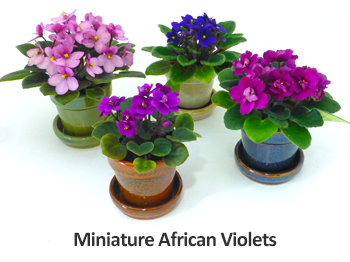 One factor of air quality that is often overlooked
is the presence of gas or chemical fumes. Common instances of these substances
may be found in natural gas (i.e., from a gas stove or other gas-operated
appliance), paint fumes or such solvents as those contained in cleaning
fluids. Depending on the precise source, gas or chemical fumes can result
in pale leaves which are smaller than normal and flowers which turn brown
and drop off.
One factor of air quality that is often overlooked
is the presence of gas or chemical fumes. Common instances of these substances
may be found in natural gas (i.e., from a gas stove or other gas-operated
appliance), paint fumes or such solvents as those contained in cleaning
fluids. Depending on the precise source, gas or chemical fumes can result
in pale leaves which are smaller than normal and flowers which turn brown
and drop off.
Prolonged exposure to gas or chemical fumes may ultimately
be fatal. For these reasons, it is important to insulate your African Violets
from any source of gas or chemical fumes. If you suspect that your African
Violets are being exposed to one of these substances, it is vital that the
source be isolated and remedied. This is as true for your African Violets
as it is for you. In fact, if your African Violets are getting sick from
the fumes, chances are, you will too.
One way to determine if gas or chemical
fumes are present has been suggested by the African Violet Society of America.
They assert that a young tomato plant, when in the presence of gas or chemical
fumes, will begin to sag within a few hours. However, even if you determine
that such substances may be present, it will still be necessary to locate
the source and correct it. If unable to do so, you should be advised to
contact a specialist, such as a natural gas technician.


"Like" Us on Facebook
for the Latest African Violet Updates & Exclusive Photos of New Varieties in Development!

To order any of the products discussed on this page,
visit
Selective Gardener
Copyright 1999-2002 Optimara/Holtkamp Greenhouses, Inc.
Nashville, Tennessee. Doctor Optimara, the Doctor Optimara logo and Optimara
Field Guide are trademarks of Holtkamp Greenhouses, Inc. Optimara, the Optimara
logo, EverFloris, MiniWell, MaxiWell, WaterShip and Watermaid are trademarks
of International Plant Breeding, A.G., Switzerland.

